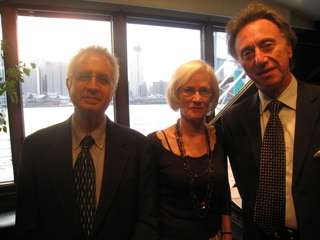|
Back
Jewish Water Music New York
BargeMusic, Fulton Ferry Landing, Brooklyn
06/25/2010 -
Paul Schoenfield: Trio for clarinet, violin and piano (1990)
David Schiff: Divertimento from Gimpel the Fool
Shulamit Ran Soliloquy (1997)
Felix Mendelssohn Piano Trio No. 1 in D minor, Op. 49
Joel Pitchon (Violin), Ronald Feldman (Cello), Paul Green (Clarinet), Doris Stevenson (Piano)

P. Green, D. Stevenson, R. Feldman (© Herring Rollmop)
That little plot of land on the East River by the Williamsburg Bridge exemplifies Shakespeare’s image of music being the food of love.
The food comes from a variety of unique venues. An old ice-cream factory, a pizzeria where customers wait for hours to have that “perfect” slice, and an ultra-expensive Italian restaurant. The love is the all-embracing view of the Manhattan skyline, glittering and glowing under the lucent night sky.
The music of course comes from BargeMusic
The barge floats and sways, but the fine musicians who in front of the bay windows looking out at the river make allowances for the tides, playing chamber works (and at times chamber opera) as diverse as the New York skyline itself. BargeMusic gives concerts all year long, but the summer sessions are especially seductive, as their website well shows.
And certainly last night, the four works by four of America’s finest independent musicians was singular. Three of the four composers were Jewish, living in America. The fourth, one Felix Mendelssohn, claimed to be a Lutheran–but Richard Wagner never believed that canard.
Still, one must ask what these four had in common besides an ethnic….er, religious….er, historical link. (One does not ask what the word Jewish implies in a mere music column.)
Two of the writers, David Schiff and Paul Schoenfield, made no bones about the “Jewish” element. This was music of the shtettels, the White Russian villages that made up the background of Fiddler on the Roof, and numerous Jewish tales, folklore and jokes. Even, sometimes, some rabbinical wisdom.
David Schiff had a reason for it. A noted scholar, author of a book on Elliott Carter, he set Isaac Bashevis Singer’s tale Gimpel The Fool to an opera (sung in Yiddish), and all four artists played a suite from that opera. The music was mainly traditional: that is, the minor modes of this amalgam of Polish, Russian and Hebrew folk music, with their syncopation, and bumptious tunes, were as natural as one would expect.
The artists were suited to the occasion, since part of the music partook of klezmer intonations, and clarinettist Paul Green is founder of Klezmer East, a klezmer-jazz ensemble. But the last movement had a cantorial recitative, which cellist Ronald Feldman essayed in his best rubato style.
Mr. Schiff did “modernize” the music a bit with a few polytonal flourishes and chords, but other than this, it was good conventional village music
The second work, Soliloquy, is by Shulamit Ran, born in Israel but today a professor of music at Chicago University. One could hardly tell either Jewish or Israeli subjects from this very introvertive work, written with two slow movements enveloping something a bit more rapid. One had the feeling of great intensity in the composition, something direct, muscular and, yes, quite attractive. But it would take more than one hearing to gather its full brunt.
I was especially looking forward to Paul Schoenfield’s Trio for clarinet, violin and piano. I had heard his Cafe Society several weeks ago and loved its Viennese, salon and jazzy interlays.
But is Mr. Schoenfield more than a I>pasticheur? Nothing was proven by this piece, though it was the first time I saw four movements described in four different languages.
Freylakh is basically Yiddish for joyful, and the three instruments played, again. Yiddish folk music with some brilliant quarter-note “off-notes” by Mr. Green. The March was a series of clever variations. Nigun, the only music not employing village music, is a Hassidic-Hebrew term of a mystical music.
Finally came the ebullient Kozatsky, which is not Yiddish, but Ukrainian, for a Cossack dance.
I wonder, though, why the first and third works relegated Jewish music to the same East European themes and modes which we know so well. Even Prokofiev and Shostakovich thought that “Jewish” music was like village music.
(I also felt that Schoenberg’s Moses und Aron would be improved if some conductor replaced the Golden Calf orgy with a more enjoyable Kozatsky.)
After the intermission–one of those glorious entr’actes when we go out and stare with wonder at the river and moon and skyline–three members of the group played Felix Mendelssohn’s First Trio. One didn’t have to make allowances for ethnic or racial or demographic allusions. This was simply a mellow and radiant work, played with perhaps too much mellowness by the group.
It was difficult to catch the agitation of the first movement Molto allegro e agitato. The three players’ proficiency couldn’t quite heighten the song-without-words twee second movement, but the marvelous scherzo was given a dazzling show by Ms. Stevenson and Mr. Pitchon.
The finale was pure Mendelssohn, which meant pure enjoyable, with neither problems nor worries.
Harry Rolnick
|